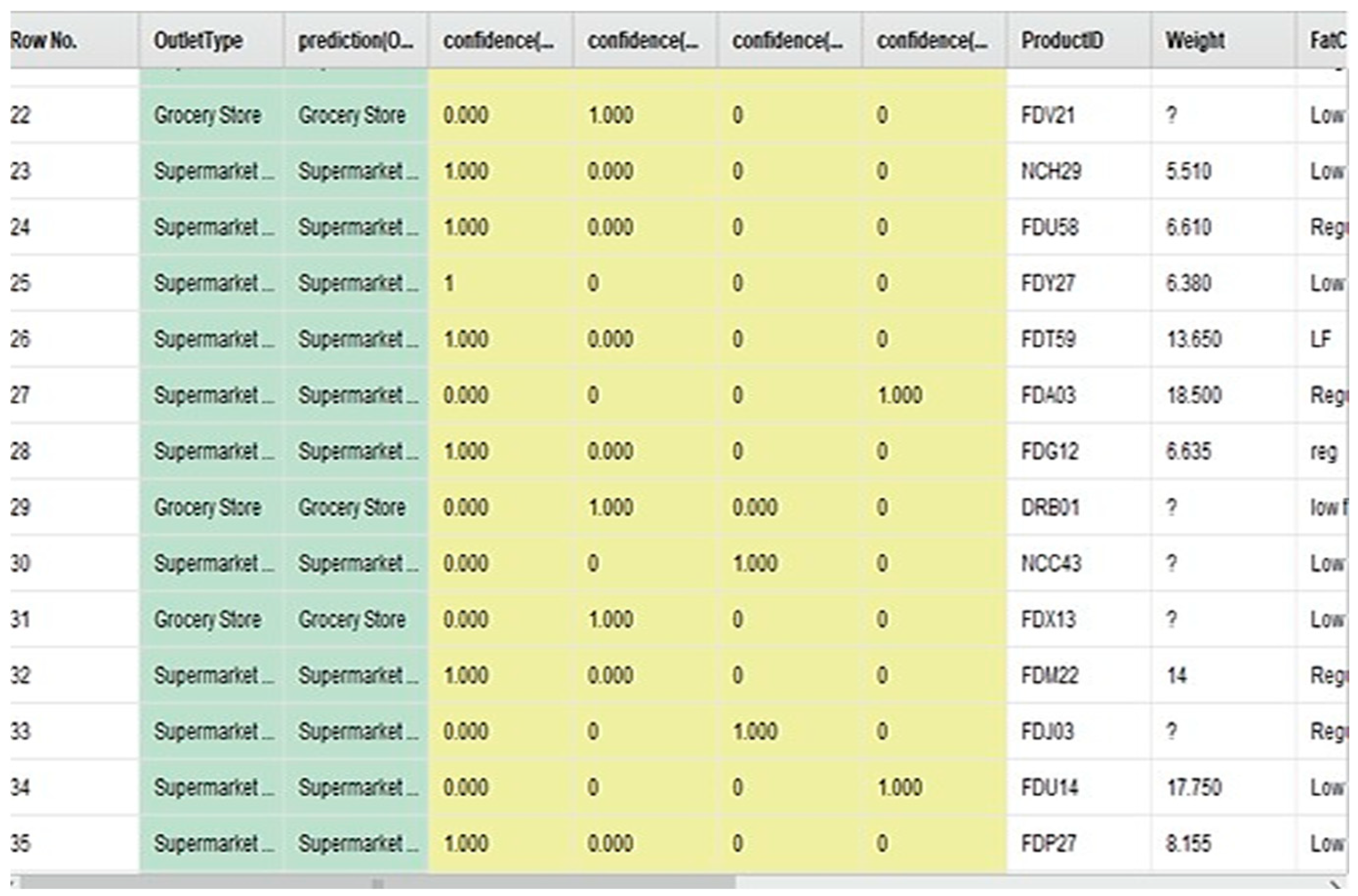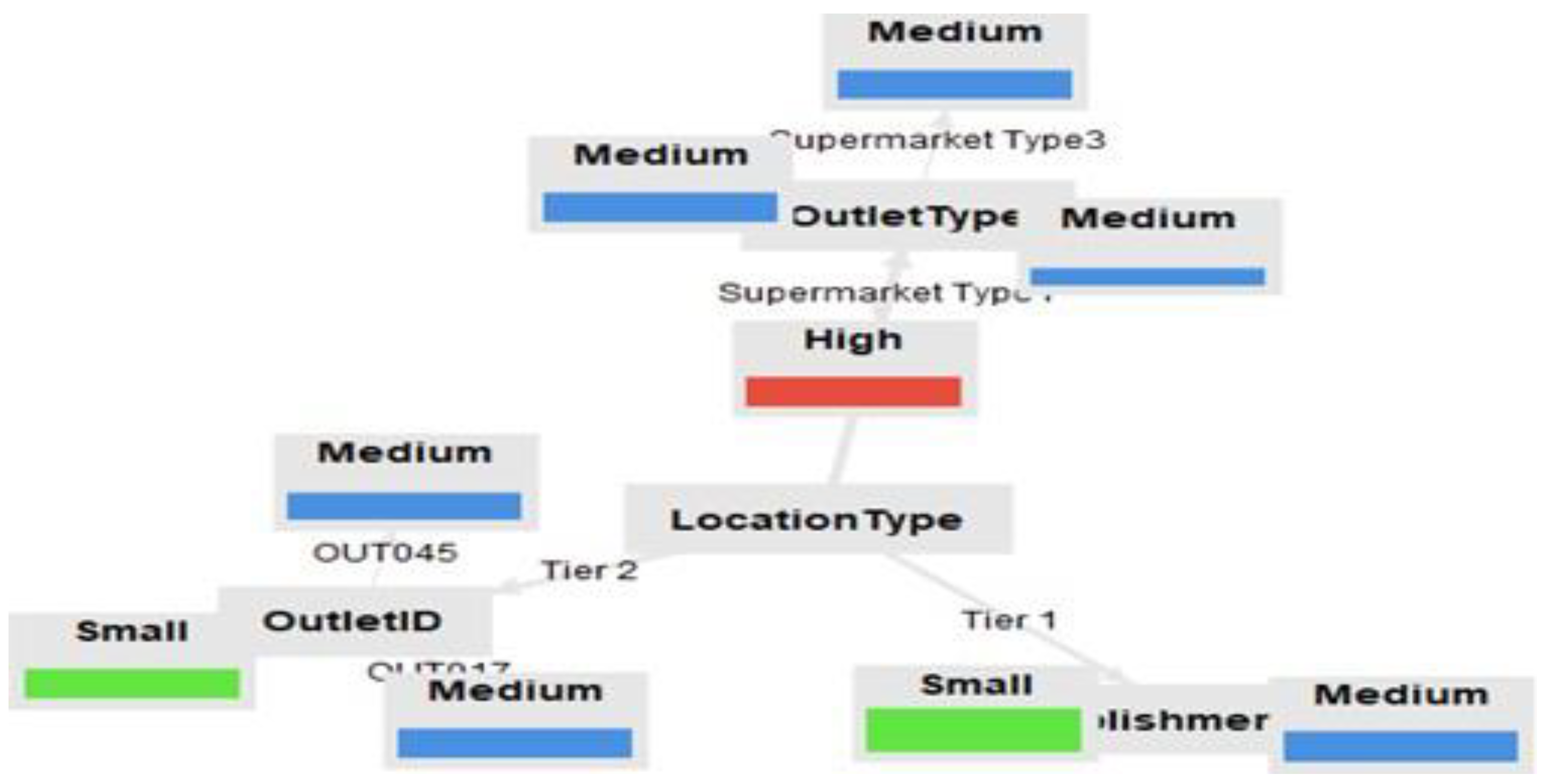Predicting Big Mart Sales with Machine Learning †
Abstract
1. Introduction
2. Literature Review
3. Proposed Methodology
3.1. KNN, or K-Nearest Neighbor
3.2. Naïve Bayes
3.3. An Unpredictable Forest
3.4. Methodology
3.5. Data Preprocessing
3.6. Data Analysis
3.6.1. Feature Selection
3.6.2. Model Deployment
3.6.3. Model Training and Testing
3.6.4. Model Evaluation
3.6.5. Implementation and Prediction
4. Results and Discussion
5. Conclusions
Author Contributions
Funding
Institutional Review Board Statement
Informed Consent Statement
Data Availability Statement
Conflicts of Interest
References
- Swetha, T.; Roopa, R.; Sajitha, T.; Vidhyashree, B.; Sravani, J.; Praveen, B. Forecasting online shoppers purchase intentions with cat boost classifier. In Proceedings of the 2024 International Conference on Distributed Computing and Optimization Techniques (ICDCOT), Bengaluru, India, 15–16 March 2024; pp. 1–6. [Google Scholar]
- Ibrahim, A.; Irawan, E.; Dewi, N.K.; Filaresy, R. The implementation of supply chain management and big data to accelerate stock order in mega drug store. J. Phys. Conf. Ser. 2019, 1196, 012005. [Google Scholar] [CrossRef]
- Kilimci, Z.H.; Akyuz, A.O.; Uysal, M.; Akyokus, S.; Uysal, M.O.; Atak Bulbul, B.; Ekmis, M.A. An improved demand forecasting model using deep learning approach and proposed decision integration strategy for supply chain. Complexity 2019, 2019, 9067367. [Google Scholar] [CrossRef]
- Gurnani, M.; Korke, Y.; Shah, P.; Udmale, S.; Sambhe, V.; Bhirud, S. Forecasting of sales by using fusion of machine learning techniques. In Proceedings of the 2017 International Conference on Data Management, Analytics and Innovation (ICDMAI), Pune, India, 24–26 February 2017; pp. 93–101. [Google Scholar]
- Ali, N.; Shah, W. Predicting Retail Sales for Walmart: A Comprehensive Study Integrating Machine Learning and Time Series Models. 2024. Available online: https://www.researchgate.net/profile/Faisal-Zaheer/publication/385518162_Predicting_Retail_Sales_for_Walmart_A_Comprehensive_Study_Integrating_Machine_Learning_and_Time_Series_Models/links/6728e1a277f274616d5c39f8/Predicting-Retail-Sales-for-Walmart-A-Comprehensive-Study-Integrating-Machine-Learning-and-Time-Series-Models.pdf (accessed on 15 September 2025).
- Kadam, V.S.; Kanhere, S.; Mahindrakar, S. Regression techniques in machine learning &applications: A review. Int. J. Res. Appl. Sci. Eng. Technol. 2020, 8, 826–830. [Google Scholar]
- Cheriyan, S.; Ibrahim, S.; Mohanan, S.; Treesa, S. Intelligent sales prediction using machine learning techniques. In Proceedings of the 2018 International Conference on Computing, Electronics & Communications Engineering (iCCECE), Southend, UK, 16–17 August 2018; pp. 53–58. [Google Scholar]
- Feng, T.; Niu, C.; Song, Y. Short Term E-commerce Sales Forecast Method Based on Machine Learning Models. In Proceedings of the 2022 6th International Seminar on Education, Management and Social Sciences (ISEMSS 2022), Chongqing, China, 15–17 July 2022; pp. 1020–1030. [Google Scholar]
- Jiang, K. Effective e-commerce price prediction with machine learning technologies. In Proceedings of the International Conference on Algorithms, Software Engineering, and Network Security, Nanchang, China, 26–28 April 2024; pp. 603–608. [Google Scholar]
- Chen, I.F.; Lu, C.J. Sales forecasting by combining clustering and machine-learning techniques for computer retailing. Neural Comput. Appl. 2017, 28, 2633–2647. [Google Scholar] [CrossRef]
- Punam, K.; Pamula, R.; Jain, P.K. A two-level statistical model for big mart sales prediction. In Proceedings of the 2018 International Conference on Computing, Power and Communication Technologies (GUCON), Greater Noida, India, 28–29 September 2018; pp. 617–620. [Google Scholar]
- Thivakaran, T.K.; Ramesh, M. Exploratory Data analysis and sales forecasting of bigmart dataset using supervised and ANN algorithms. Meas. Sens. 2022, 23, 100388. [Google Scholar] [CrossRef]
- Mondal, S.; Debbarma, A.; Prakash, B. Big mart sales prediction using machine learning. In Proceedings of the 2024 10th International Conference on Communication and Signal Processing (ICCSP), Melmaruvathur, India, 12–14 April 2024; pp. 742–747. [Google Scholar]
- Wen, K.Y.; Joseph, M.H.; Sivakumar, V. Big Mart Sales Prediction using Machine Learning. EAI Endorsed Trans. Internet Things 2024, 10. [Google Scholar] [CrossRef]
- Agbonlahor, O.V. A Comparative Study on Machine Learning and Deep Learning Techniques For predicting Big Mart Item Outlet Sales. Doctoral Dissertation, Dublin Business School, Dublin, Ireland, 2020. [Google Scholar]
- Ashfaq, F.; Jhanjhi, N.Z.; Khan, N.A.; Das, S.R. Synthetic crime scene generation using deep generative networks. In Proceedings of the International Conference on Mathematical Modeling and Computational Science, Madurai, India, 24–25 February 2023; Springer Nature: Singapore, 2023; pp. 513–523. [Google Scholar]
- Diwaker, C.; Tomar, P.; Solanki, A.; Nayyar, A.; Jhanjhi, N.Z.; Abdullah, A.; Supramaniam, M.A. A New Model for Predicting Component-Based Software Reliability Using Soft Computing. IEEE Access 2019, 7, 147191–147203. [Google Scholar] [CrossRef]
- Kok, S.H.; Abdullah, A.; Jhanjhi, N.Z.; Supramaniam, M.A. A Review of Intrusion Detection System Using Machine Learning Approach. Int. J. Eng. Res. Technol. 2019, 12, 8–15. [Google Scholar]
- Ahmed, S.; Hossain, M.A.; Bhuiyan, M.M.I.; Ray, S.K. A Comparative Study of Machine Learning Algorithms to Predict Road Accident Severity. In Proceedings of the 2021 International Conferences: IUCC, CIT, DSCI, SmartCNS, London, UK, 20–22 December 2021; pp. 390–397. [Google Scholar] [CrossRef]




| Models | Model Accuracy |
|---|---|
| KNN | 86.68% |
| Naïve Bayes | 95.56% |
| Random Forest | 100% |
| Authors | Years | Dataset | Classifier | Accuracy |
|---|---|---|---|---|
| Gopal Behera and Neeta Nain | 2020 | Big Mart sales dataset | XGBoost | - |
| Rao Faizan Ali and Amgad Muneer | 2023 | Big Mart sales dataset | RF, RR, LR, DT | Outperformed |
| Punam Kumari, Rakesh Pamula, and Praveen Kumar Jain | 2018 | Big Mart sales data | RF, MLR | - |
| Imran Bin Ibrahim and Syed Adnan | 2023 | Big Mart sales data | XGBoost, LR, PR, RR | Outperformed |
| Artika Arista, Theresiawati Theresiawati, and Henki Bayu Seta. | 2024 | Big Mart sales data | XGBoost, LR, PR, RR | - |
Disclaimer/Publisher’s Note: The statements, opinions and data contained in all publications are solely those of the individual author(s) and contributor(s) and not of MDPI and/or the editor(s). MDPI and/or the editor(s) disclaim responsibility for any injury to people or property resulting from any ideas, methods, instructions or products referred to in the content. |
© 2025 by the authors. Licensee MDPI, Basel, Switzerland. This article is an open access article distributed under the terms and conditions of the Creative Commons Attribution (CC BY) license (https://creativecommons.org/licenses/by/4.0/).
Share and Cite
Husban, M.; Mir, A.; Yustiana, I. Predicting Big Mart Sales with Machine Learning. Eng. Proc. 2025, 107, 95. https://doi.org/10.3390/engproc2025107095
Husban M, Mir A, Yustiana I. Predicting Big Mart Sales with Machine Learning. Engineering Proceedings. 2025; 107(1):95. https://doi.org/10.3390/engproc2025107095
Chicago/Turabian StyleHusban, Muhammad, Azka Mir, and Indra Yustiana. 2025. "Predicting Big Mart Sales with Machine Learning" Engineering Proceedings 107, no. 1: 95. https://doi.org/10.3390/engproc2025107095
APA StyleHusban, M., Mir, A., & Yustiana, I. (2025). Predicting Big Mart Sales with Machine Learning. Engineering Proceedings, 107(1), 95. https://doi.org/10.3390/engproc2025107095





